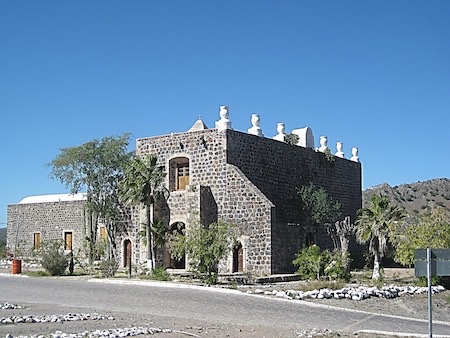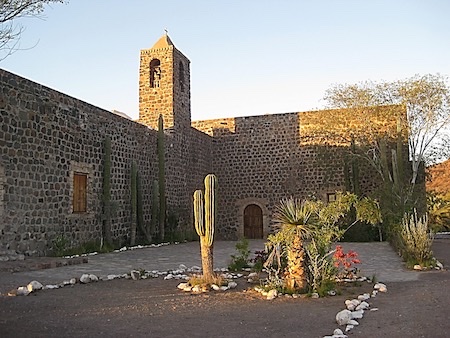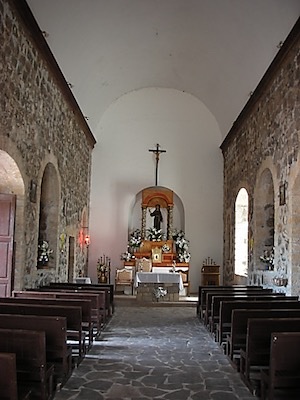 |  |
By David Kier

The first Spanish California missions were more of a test than a success, but the Jesuits had much faith. In 1683, Padre Eusebio Kino with the Spanish Admiral Isidro de Atondo y Antillón twice attempted to build a colony on what they thought was the island of California. The first attempt was at La Paz. It failed after just three months. “Uncooperative Natives” was the reason given. That the military fired their cannon upon them for a minor offense, killing several, would seem to cause unrest, with anyone!
The Spanish, with Padre Kino, regrouped on the mainland. They crossed again, but this time further north, at San Bruno, where the Cochimí Natives were much friendlier. That colony lasted two years before water and supplies both gave out. Their hilltop fort, in the shape of a triangle, is visible today and remains the oldest European ruins in all the Californias. To Kino, these colony projects taught him what was needed to have success in California. Mainly, the Jesuits must have control over the military to prevent any more violence against the Californians by the military.
New arrangements were made between the Jesuits and the Spanish Crown. The soldiers sent would be under the control of the Jesuits. In turn, the Jesuits had to finance the entire California mission program and they were given autonomy over California. After gaining sponsorship from some wealthy Europeans, the program began with the first mission of Loreto, in 1697. The second mission was San Javier in 1699, and more Jesuits arrived.

Before the end of 1705, two more missions would be added; one at Ligüí, to the south of Loreto. The other would be at Mulegé. Two Jesuits left Loreto together on November 21st and traveled to their new mission sites. Mulegé, being that it is four times further away, made it the fourth California mission, after Ligüí. The exact founding day seems to have been lost to time. The mission was named for Santa Rosalía, by request of its benefactors (Nicolás de Arteaga and his wife, Josefa de Vallejo) who pledged 10,000 pesos. Nearly 200 years later, the French applied this same name to their copper mining town, 38 miles north. Mulegé is the Native Cochimí name for the location.
As with all missions, the first structure is made of sticks and leaves, to shelter the altar and Holy vestments used by the priest, Padre Manuel de Basaldúa. These first shacks would be replaced by adobe rooms. In 1709, Padre Francisco Píccolo would relieve Basaldúa who became ill. In 1717, a great flood wiped out the early mission buildings and its farmlands. Floods in Mulegé are not a new phenomenon! In time and with growth, the mission church was moved higher up, out of harm’s way.

In 1719, the need for reliable transportation across the Gulf of California would be realized when Padre Juan de Ugarte learned of a forest of suitable trees from which a proper Jesuit ship would be constructed at Mulegé. Ugarte, the Jesuit at Mission San Javier, had become the Superior of the California Jesuits (or Padre Visitador), in 1718. A grove of güéribo trees was located in the mountains west of Mulegé that would serve for the ship’s construction. This region was called Huasinapí by the Cochimí Natives. The timber-cutting and hauling event inspired them to request a mission of their own. Click here for more details.
The exact location of the trees cut in 1719, was confirmed in 2015. Enjoy this detailed slide show. It surely was a monumental undertaking by Ugarte to cut and move the logs using oxen, soldiers, and Native labor, a great distance over the mountains to Mulegé.
With skilled masons from the mainland, a large stone church and bell tower was constructed from 1757 (or earlier) to 1766. The Jesuits would soon be expelled from their missions, in January 1768. The reason given for their expulsion was that they hoarded treasures! This would later be disproven.
Another devastating flood occurred in 1770, causing the Franciscan padres, who had replaced the Jesuits in 1768, to consider moving the mission north to a place called Magdalena. While there were interesting ruins and a long aqueduct built at La Magdalena, no records indicate who built them or when they were constructed. Various authors have claimed them to be either Jesuit or Dominican. A chapel, in ruins today, is located a few miles to the west, in the valley of San José de Magdalena. It was called a Dominican visita by some, but evidence shows it was post-mission construction to serve new settlers from the mainland. The Magdalena ruins were mostly destroyed by a 2014 flash flood which widened the nearby arroyo and undermined the stone walls. See my 2009 trip article Mysterious Magdalena Ruins and after the destruction, in my 2015 revisit article La Magdalena Revisited (with before and after satellite images).
The Dominicans missionaries arrived to replace the Franciscans. The Franciscan were quite happy to have only Alta California missions to build and manage. The Dominicans reported they found the mission of Santa Rosalía de Mulegé nearly deserted, after swarms of locusts and the flood of 1770 had destroyed the crops. The population in 1782 was down to just seventy-five people.
By 1783, the Dominicans had repaired the irrigation system to improve agriculture. Sadly, the population continued to drop. The only increase came in 1795, when the mission of Guadalupe was abandoned and some of that mission’s population relocated to Mulegé. This only increased the population to eighty-eight. In 1798, six adobe cottages were built for the Native Californians. By the year 1808, the population was now only thirty-nine.

Somehow, the mission stayed open for twenty more years, ending mission services in 1828. This was six years after both Baja and Alta California’s governments were transferred from Spain to the new independent nation of Mexico. The last recorded missionary at Mulegé was Padre Tomás de Ahumada, who arrived in 1815 from his far-north mission of San Miguel, which is located at the school in today’s town of La Misión (along the free road to Ensenada).
The Mulegé mission’s stone church has since served the Mexican population who arrived in Baja California following the mission’s closure and was made into their parish church. When you drive on Highway One, and cross the tall bridge over Mulegé’s tropical river, glance over to the right and see the magnificent building that has stood there for over 250 years. Access the mission via a 1 km. long road, at Km. 134. Turn left onto it, soon after crossing the bridge.
Photographs are from my visits in 2007, 2016, 2017, and 2019.
About David
David Kier is a veteran Baja traveler, author of 'Baja California - Land Of Missions' and co-author of 'Old Missions of the Californias'. Visit the Old Missions website.

It was simple to purchase coverage and feeling that I was protected.

I highly recommend Baja Bound if you need insurance south of the border. I have been using them for...